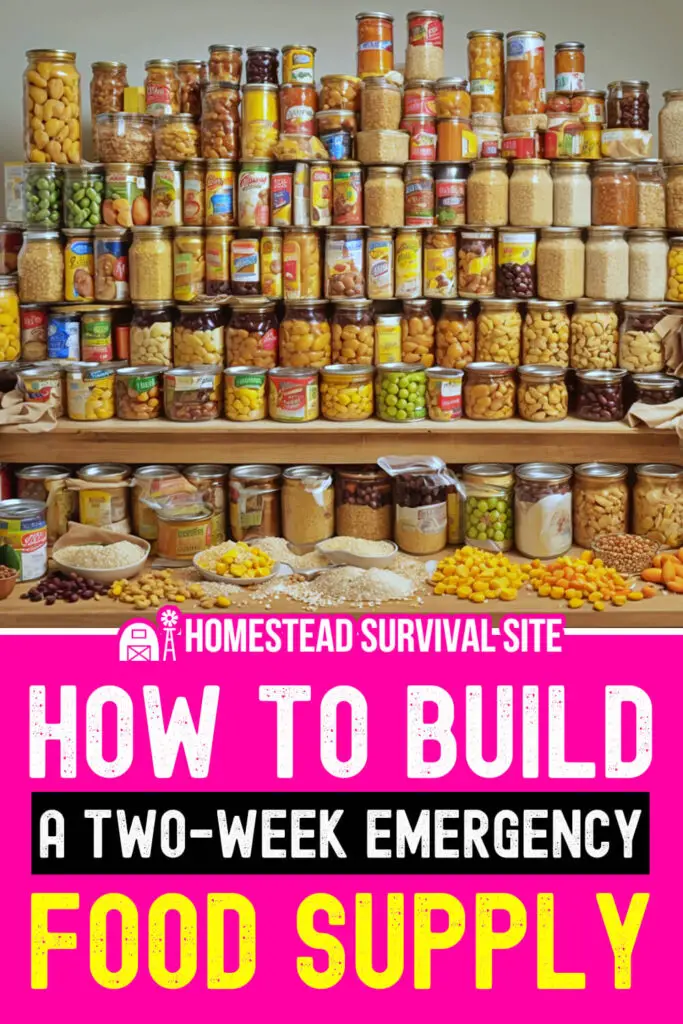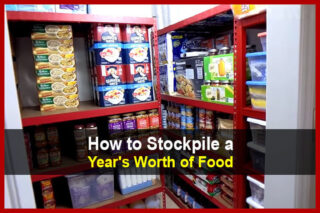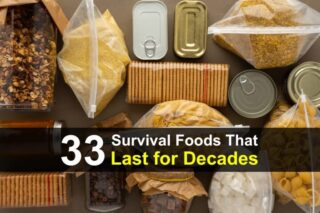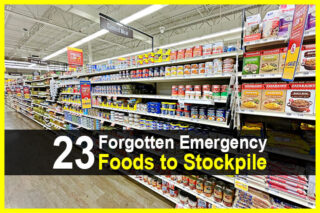Estimated reading time: 11 minutes
It’s easy to put together a two-week food supply, but how long that food will stay shelf-stable without spoiling is the big question. A lot of times when we stockpile or store things for an emergency we take the set-it-and-forget-it approach. The task shows up on our to-do lists and once we’ve checked it off, we move on to the next project. In the process we forget about that food stored in the basement.
The solution often touted for anyone stockpiling or storing food is to eat what you store and store what you eat. That’s a good idea but it sounds a lot simpler than it is. It means you have to constantly keep track of what you’ve eaten and then judiciously replace it.
Some will argue that it’s as simple as keeping an extra two-weeks of food in the house at all times. That could work too. But then, we forget or we delay restocking while we wait for the next sale or the next paycheck. The key is to stockpile foods that have a long shelf-life so that if you do forget it, it won’t surprise you when it’s spoiled in an emergency.
Want to save this post for later? Click Here to Pin It On Pinterest!
Why Two Weeks?
There’s actually a statistical basis for stockpiling a two-week supply of food. Many of us are familiar with the idea of a 72-hour kit. It’s recommended by FEMA and other disaster agencies and is based on the average time someone is away from their home during an evacuation. These 72-hour kits also include a 3-day supply of food.
What’s often missed is that these disaster agencies also recommend a secondary backup plan for two-weeks. This is usually recommended when someone is bugging-in and is forced to stay home to wait out the disaster and its after-effects. 72 hours is the average for most disasters but when any disaster has effects beyond 72 hours the extended average duration is statistically two weeks.
And that can be a long two weeks. It’s most likely it’s two weeks either away from home or living in your home without electricity, running water, heat or air-conditioning. In addition, there will most likely be a severe strain on local resources as many stores are closed and local emergency management is overwhelmed.
There’s certainly more to preparing to survive two-weeks in the midst of disaster, but food is not only necessary but is often comforting in times of extreme stress.
Beyond the Checklist
We’ll eventually get to a checklist of recommended food items for a two-week emergency supply, but there’s a problem with checklists. For one, people’s tastes vary. For another, 10% of Americans have diabetes which severely limits some foods that show up on a generic checklist.
There’s also the kids to think about. Sardines in oil may have good nutritional value but it’s one of those foods most kids won’t eat. Finally, there’s the cost factor. Some people struggle to keep a few days worth of food in the house let alone a 2-week surplus.
For all of these reasons we’re going to take a conceptual approach to 2-weeks of emergency food that will cover key points on nutrition, shelf-life and cost-savings. After that we’ll get to our checklist. But one other note -this is only for two weeks. We don’t have to reinvent the wheel. As long as you can maintain a decent calorie intake with a good balance of vitamins and minerals we’ll most likely survive.
Then again, it’s going to be a stressful and demanding two weeks so it deserves some thought.
Emergency Nutrition 101
Nutrition guidelines are specific but can vary depending on an individual’s age, gender and overall health. The best nutrition is defined as the satisfaction of some fundamental dietary needs. Here are the things that you’ll need to fulfill to sustain basic nutrition. It’s only for 2 weeks so it doesn’t have to be perfect but in stressful times it’s smart to get it right.
√ Calories
There are two types of calories: calories from carbohydrates and calories from fats. The carbohydrate calories give us instant energy and a burst of body heat. The calories from fat provide long-term internal body heat that’s critical in winter. Calories from fat also provide some of the good, heart-healthy fats like Omega-3 fatty acids.
The point is to keep an eye on the calories in the foods you store. The average, active adult male needs at 2500 calories a day to maintain body weight and good general health. Women need around 2,000 calories and kids vary depending on age and body weight. Here’s a link to a chart to give you a sense for recommended daily calorie counts by age and gender.
√ Protein
Protein is often missed in many specialized foods processed specifically for long-term food storage. Many of the calories from those foods are calories from carbohydrates like grains, cereals and sugars.
The best source of protein for food storage fall in the category of canned meats and fish. They are also a good source of calories from fat and the fish offer the good fats with Omega-3 fatty acids from canned tuna, salmon, mackerel and that kid’s favorite –sardines.
Make sure you have some canned meats in your 2 week supply and some canned fish as well. If you want to boost the calorie count, buy the canned tuna or other fish canned in oil rather than water. And don’t forget that nuts are another excellent protein source.
√ Vitamins and Minerals
Start by storing a bottle of multi-vitamins. Have a bottle of kid’s multi-vitamins as well. Take them every day during your 2-week disaster. In addition, think about storing some canned fruits, vegetables and healthy and fortified cereals like granola.
√ Fiber
A lot of your fiber intake will take care of itself if you have a good supply of canned fruit, vegetables and cereals. Oatmeal is a good thing to add along with some dried fruits like raisins, cranberries (Craisins), dried apricots and others. You can snack on them or add them to the oatmeal or cereal.
√ Beverages
Water is the most critical and you should have at least a gallon a day per person and that’s just for drinking water. However, if you add a drink mix, powdered milk or electrolyte powder to your water you’ll maintain hydration.
Another benefit of canned foods is they don’t need additional water for rehydration so if you’re concerned that water will be in short supply –avoid foods that require a lot of water for cooking.
The Frugal Prepper
We mentioned the cost issue and with the continuing high prices for food it may be difficult for some people to suddenly stock up on a lot of food. There are solutions. Here are few:
√ Home Canning and Food Preservation
If you have any experience with food preservation techniques you may already have some food in storage. Canning and preserving foods your self is a good way to save money. Here are some links to key articles that could help you assemble and preserve a lot of the foods you grow or buy in bulk and save a lot of money:
- Canning 101
- How to Can Meats
- How to Can Beef
- Hurdling as a Food Preservative Strategy
- Wild Foraging Grains and Seeds
- How to Turn Almost Anything Into Flour
- Survival Meats from Pemmican to Jerky
√ Shop the sales
This may seem obvious but when you see a sale at a grocery store ask yourself if the sale items could satisfy your emergency food storage. Like we said, 2-weeks really isn’t all that long and if you keep an eye on sales over the months you can fill out your 2-week emergency supply fairly well.
√ Shadow the Holidays
After the holidays, many foods associated with those holidays will appear on sale. Turkeys after Thanksgiving and Christmas, seafood after New Years, Corned Beef brisket after St. Patrick’s Day, hams after Easter, the list goes on.
Most sound like they’ll need to be frozen but getting back to the food preservation techniques we listed; you could find a way to preserve any of these foods for your 2-week emergency stockpile. There are also other items that are very shelf-stable like canned cranberries, stuffing mixes and other sides that show up in those sales as well.
√ Shop the Warehouses
Costco, Sam’s Club, and some others not only offer bulk savings but also offer sale prices on items from time to time. This is a great way to not only shop for your everyday foods but set some aside for your 2-week food supply.
√ Join Grocery Store Rewards Programs
Digital coupons have become very popular through grocery store rewards programs. The idea is to offer deep discounts on some loss-leaders in the hopes that they can draw you in for the deal while you shop for the regular priced items as well.
Don’t do that. Go there and buy what’s on sale with the digital coupon if it fits into your food storage plan. Typically you can buy more than one item with the discount. Stock up for home and for your 2-week food supply –and then don’t buy anything else until you really need it.
Just Plan Ahead
If you take your time and shop wisely you can put together 2-weeks of extra food without putting a huge dent in your budget if money is tight. Just make sure your mindful of the shelf-life of the things you’re buying. Here are some links to articles about the shelf-lives of various foods:
Two-Week Emergency Supply Checklist
Here’s the checklist. Think of it as thought starters for your 2-week food supply. You’ll need to adjust quantities based on the size of your family or group. That’s why it makes sense to consider calorie needs for different ages.
You don’t have to buy everything but each category or group represents the nutrition ideas we covered, so at least get some of each from each category. Add more if you want more variety and remember the kids if that’s a consideration for your family or group.
2-Week Emergency Food Supply Checklist
- Mixed Nuts
- Peanut butter
- Dried Black Beans
- Dried Pinto Beans
- Canned Beef
- SPAM
- Canned chili with meat
- Canned chicken
- Canned Tuna in oil
- Canned Sardines in oil
- Canned Corned Beef Hash
Vegetables:
Fruit:
- Canned Mixed fruit
- Canned Mandarin oranges
- Canned Cranberries
- Applesauce
- Canned pears
- Dried mixed fruit
- Raisins
- Dried cranberries
Cooking fats
Beverages
Sauces etc.
- Soy sauce
- Ketchup
- Mustard
- BBQ Sauce
- White Vinegar
- Jams and jellies
- Pancake syrup
- Honey
Soups
- Canned vegetable beef
- Canned chicken noodle
- Beef and chicken bouillon cubes
- Canned cream of mushroom
Dry Goods
Most dry goods will have an extended shelf life if resealed in Mylar bags. Less fragile dry goods like popcorn and rice can be vacuum sealed to extend shelf-life.
- White rice
- Assorted pastas
- Instant mashed potato flakes
- Instant gravy mixes
- Popcorn (whole kernel)
- Whole grain crackers
- Flour (whole wheat berries store longer)
- Corn meal
- Mac and cheese
- Hard candy (longer shelf-life than other candies)
- Cereals (granola, oatmeal, kid’s cereals)
Baking and Cooking Supplies
- Salt and pepper
- Baking powder
- Baking soda
- Yeast (but will become inactive over time unless refrigerated)
- White sugar
- Corn syrup
If your tastes vary, substitute as much as you like but try to remember to keep a balance between nutrition, shelf-life and ease of preparation.
Food Packaging and Repackaging Basics
One of the keys to food shelf-life is the integrity of the packaging. Cans are best, bottles are okay and cardboard boxes and the most fragile. Try to buy foods that are either canned or vacuum sealed in Mylar bags.
If the foods are in a fragile package like a plastic bag or cardboard box you can reseal them in either a vacuum sealed bag, a sealed Mylar bags or specialized containers that offer a more stable environment. Adding oxygen absorbers is another way to extend shelf-life so think ahead.
Successful Long-Term Food Storage
The final factor to consider for any food supply you’re trying to store over a long or even short-term is proper storage. A refrigerator or freezer is best but we can’t count on those things during an emergency.
The best alternatives are the old-world solutions like root cellars or even your basement. Many of us have noticed that any trip down to the basement is usually met by a colder temperature down there. Keep your everyday stuff in the kitchen pantry but try to keep your 2-week food supply in the coolest, darkest location in your home.
For most of us, that’s probably the basement, unless you are fastidious about eating what you store and storing what you eat. Here are some links to some good articles about food storage solutions:
- Food Storage 101
- All About Root Cellars
- Food Storage Locations for Apartment Dwellers
- Foods You Should Always Keep Stored in Your Car
- Recognizing When Food Storage Has Gone Bad
This Really Isn’t That Hard
Some preppers have a year’s supply of food and more in storage. They probably skipped this article. But given the way our climate keeps throwing us weather extremes and the results that often follow like wildfires and floods, it makes sense to at least have 2 weeks of food in storage. Emergency management agencies around the world recommend it and for anyone with a risk-averse mindset, it just makes sense.
Like this post? Don't Forget to Pin It On Pinterest!
You May Also Like:












